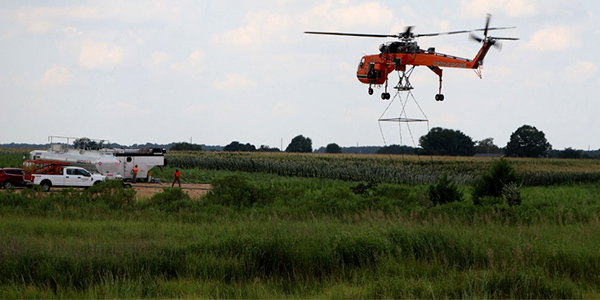By Rich Heidorn Jr.
The long-running dispute over who pays for PJM’s first Order 1000 transmission project is finally nearing an end.
The $266.5 million Artificial Island stability project likely also generated millions in legal fees over the past six years, first in a fight over competitive bidding before PJM and later in an epic cost allocation saga before FERC.
On Thursday, FERC ended its refereeing in the cost allocation battle, rejecting a challenge to an April 2016 cost allocation order as moot because it was later reversed (ER15-2563). The commission also terminated docket EL15-95-002, saying rehearing requests in it have already been addressed in other dockets. Still pending is a petition filed by PPL Utilities in February asking the D.C. Circuit Court of Appeals to review three commission orders in the dispute.
Meanwhile, the project, which includes a new transmission line between New Jersey and Delaware, is scheduled to be completed by the end of May. The project is designed to address stability limits on generation at the Salem and Hope Creek nuclear plants in New Jersey and transmission constraints that sometimes prevent the generators from exporting power at full capacity.
Stability vs. Power Flow
The original cost allocation would have assigned virtually all the costs of the project to Delaware and Maryland ratepayers, prompting state regulators to file a complaint alleging that the use of the solution-based distribution factor (DFAX) method was unjust and unreasonable when the benefit was system stability rather than power flow (EL15-95). In April 2016, the commission denied the complaint and accepted PJM’s proposed cost allocation (ER15-2563).
In July 2018, however, the commission reversed itself, finding the use of the solution-based DFAX unjust and unreasonable for stability-related reliability violations like that of Artificial Island. (See FERC: Stability Deviation Method Best for Artificial Island.)
On March 16, 2020, the commission accepted cost responsibility assignments for 20 baseline transmission projects, including reallocation of cost responsibility for Artificial Island based on the stability deviation method (ER20-736).
The commission’s Thursday order said that although it had initially accepted cost allocations using DFAX, the cost assignments never went into effect, rendering the rehearing requests in docket ER15-2563-002 moot.
“We’re excited about the end of the FERC process,” Sharon Segner, vice president of LS Power, said Monday. “It’s a big victory for Delaware consumers.”
LS Power won a share of the Artificial Island project after challenging PJM’s original award to Public Service Electric and Gas and promising to cap its cost at $146 million. Last month, FERC approved rules on how PJM will evaluate voluntary cost commitment proposals in the future. (See FERC OKs PJM Tx Cost Containment.)
LS Power Group’s Silver Run Electric is building a new substation in Delaware and a 5.5-mile, 230-kV transmission line, including a 3-mile crossing under the Delaware River, between the substation and the Hope Creek nuclear plant.
Nearly Done
The project, PJM’s first competitive solicitation under Order 1000, has a projected in-service date of June 1, according to PJM records.
“It’s nice when you’ve spent so much time on the policy side of Order 1000 seeing the fruits of LS Power’s work,” said Segner, who is a regular presence at PJM stakeholder meetings on transmission. She said FERC’s Standards of Conduct prevent her from sharing nonpublic, market-sensitive details about the status of the transmission construction.
LS Power is one of three companies building the project.
Delmarva Power is interconnecting the Silver Run substation with the existing 230-kV Red Lion-Cartanza and Red Lion-Cedar Creek lines for $2 million.
PSE&G is expanding its Hope Creek substation with a new 500/230-kV autotransformer and a new 500-kV bay for a combined $118.5 million.
Excluding the $51.5 million 500-kV bay at Hope Creek — which was allocated 50% based on load-ratio-share among 22 transmission zones, and 50% on the stability deviation method — the costs were allocated based on stability deviation among 10 transmission zones.






